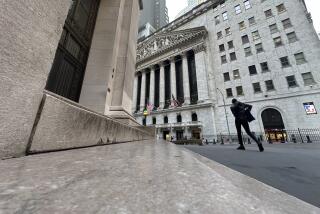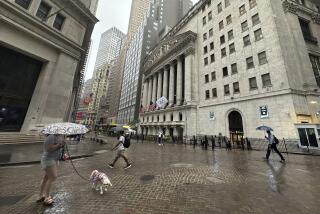Dow Reverses Plunge, Regains Half of Losses : Stock Market: The 88-point rebound defies fears that Wall Street was in for a replay of the crash of 1987.
NEW YORK â History did not repeat itself on Monday.
The Dow Jones industrial average, instead of plunging lower, recovered nearly half of Fridayâs losses, gaining 88.12 points to close at 2,657.38. Trading volume was the fourth-largest ever, 416.29 million shares, surpassed only by three extraordinary days during and after the crash of October, 1987.
The rebound defied fears that the market was in for a replay of two years ago, when a big drop on a Friday presaged the 508-point crash the following Monday. Traders said that crash had psychologically prepared investors to weather this past Fridayâs 190.58-point âcorrection, â and efforts to calm investors over the weekend apparently worked. Market analysts said investors recognized that basic economic and market conditions were more favorable than they were two years ago.
âTwo years ago, people were unable to do anything because of the sheer momentum, the panic,â said Glen Stevens, a stockbroker at Bateman Eichler, Hill Richards Inc. in Los Angeles. âToday, people said this was not a panic--this was a buying opportunity.â
Still, the buying Monday was heavily in blue-chip stocks, and at the close declining stocks outnumbered those that had gained in price by 5 to 4 on the New York Stock Exchange. Some market experts said the sharp drop Friday may indicate the start of a bear market, and some said that big market swings of 100 points or more in a single day may become fairly routine.
Nevertheless, by mid-morning Monday, it was clear that the panic that had led the Dow index to fall more than 100 points in an hour on Friday had spent itself. There was a general feeling that Fridayâs drop, in fact, had been an overreaction to fears that some takeover deals were in trouble.
At the close of trading on the NYSE, 975 issues were down in price, 749 were up and 279 were unchanged. The value of all stocks regained about $58.64 billion of the $189.5 billion lost on Friday.
John J. Phelan, chairman of the NYSE, described Monday as âa reasonably normal 400-million-share, up-88-point day.â He said Fridayâs plunge had been nothing more than âa very sharp squall.â
Phelan and officials at the futures and options exchanges said the markets operated relatively smoothly Monday despite the huge trading volume. This was in contrast to Black Monday in 1987, when the electronic tape that lists stock prices lagged as much as 1 hours behind the actual trading.
This time, a NYSE spokeswoman said, the tape was up to the minute all day except for a 15-minute period in the first half hour of trading, when prices were four minutes late. Market officials attributed the better performance to improved computer systems and other safeguards put in place in the aftermath of the 1987 crash.
The NYSE also implemented new procedures that gave orders from small investors priority over big institutional trades.
As was widely expected, the market began the day sharply lower. In the first half hour of trading, the Dow index had fallen about 63 points below its close of 2,569.26 on Friday. More than 80 NYSE-listed stocks did not immediately open for trading because of âorder imbalancesâ--far more sellers than buyers.
Then several key stock index futures began to rise. And as the prices of the futures rose, the prices of the underlying stocks started to go up, too. By 10:30 a.m., the Dow index had decisively moved up from Fridayâs close. Although it moved somewhat erratically for the rest of the day, it remained up and closed near its high point for the day.
The 88-point rise was the fourth-largest gain ever in terms of points but not a leader in terms of percentage gain. All of the NYSE stocks that had order imbalances resumed trading by the end of the day, a spokeswoman said.
Most of Fridayâs market drop occurred in the last hour of trading, and the apparent free-fall was halted only by the end of the session. This led to worries that investorsâ fears would solidify over the weekend and that foreign investors might also begin to dump stocks.
But reports on Sunday that the Federal Reserve had promised to support the financial system with additional cash reserves, as well as speculation that interest rates might decline, appeared to soothe fears. In addition, when the Tokyo stock exchange opened Sunday night, U.S. time, for the first time since Fridayâs drop, the Nikkei index closed down only 1.8%, far less than had been feared.
On top of this, market strategists said, investors had far more cash in their portfolios this week than in 1987, when they tended to be fully invested in stocks. They were therefore less exposed this time to a sudden drop in stock prices and also better positioned to snap up stocks at bargain prices.
âThere was a good deal of cash around,â said Ken Spence, head market technician at the investment banking firm Salomon Bros. âPeople were better prepared to take advantage.â
Abby Joseph Cohen, chief strategist for Drexel Burnham Lambert Inc., also said that, unlike in 1987, commercial banks didnât start to cut off credit to brokerage firms. She said the banks apparently were assured by word that the Fed stood ready to pump additional funds into the financial system.
Underlying all of this, most analysts said, were the fundamental reasons why a crash was far less likely now than two years ago. The economy has been growing at a more stable rate. Interest rates in general have been moving down instead of up. The dollar has been strengthening on foreign exchange markets. And stocks in general are far less overvalued than they were in October, 1987, when prices averaged 22 times companiesâ earnings per share. The ratio of price to earnings averaged only about 13 at the start of this month.
During the day, the impetus to buy stocks was fueled by most of the major brokerage firms recommending that customers increase the percentage of stock in their investment portfolios. Steven Einhorn, chairman of the investment policy committee at Goldman, Sachs & Co., said his firm recommended that investors increase their stock holdings by 5 percentage points, to 65% of their total investments, because âthe economy still looks fineâ and âthe underpinnings of the market were still good.â
Some analysts warned, however, that Fridayâs drop may have put an upper limit on the market that will last for some time. They said there may be some additional sharp declines, in effect aftershocks from last weekâs tumble. âWeâre not out of the woods yet,â said Alan Shaw, manager of technical research at Smith Barney, Harris Upham & Co. âYou donât necessarily get right back up and run a mile.â
Fridayâs abrupt drop was set off when the investor group attempting to buy United Airlinesâ parent company announced that it had failed to get financing for its $6.75-billion offer. This capped weeks of fears that takeover financing in general was drying up, prompting a massive selloff of stocks thought to be potential takeover targets.
As the rise in the Dow index seemed well under way Monday afternoon, there was briefly widespread fear that it might be undermined when real estate developer Donald J. Trump said he was withdrawing his offer to buy the parent company of American Airlines. This led to a temporary halt in trading in the stock of the company, AMR Corp., because of a flood of sell orders. But the news did not thwart the marketâs overall recovery.
âIt was clear that we were going to have an up day when the market rallied back in the face of the American Airlines news,â said Larry Wachtel, a stock market commentator at Prudential-Bache Securities.
President Bush, asked at a White House ceremony at which he signed a proclamation of World Food Day whether he was worried about the market, replied âno.â
Asked why Bush expressed no concern, White House Press Secretary Marlin Fitzwater said: âItâs based on the knowledge that the Treasury and the Fed and the SEC have good people who are aware of the situation and watching it, that the economy is strong, that our investors will react accordingly.â
The rise in the stock market Monday reversed the âflight to qualityâ that had taken place on Friday, when investors rushed to pull their money out of stocks and into normally more stable securities, such as Treasury bonds. The benchmark 30-year Treasury bond was off by 1.25 points. Prices of shorter-term Treasury bills also plummeted.
One encouraging sign was that the junk bond market showed its first significant rise in weeks, after tumbling severely on Friday. Junk bonds are heavily used to finance takeovers, and the state of the market for the high-yield, high-risk bonds may be an indicator of the availability of takeover financing.
Staff writers Karen Tumulty in New York and Jesus Sanchez and George White in Los Angeles contributed to this story.
AND VOLUME SOARS...New York Stock Exchange trading hit 416.29 million shares Monday, the fourth heaviest day in history.
THE MARKETâS 10 TOP TRADING DAYS
New York Stock Exchange volume hit 416.29 million shares Monday, the fourth heaviest in history and nearly twice the 251.17 million shares traded Friday. Here are the 10 most active days on record. Oct. 20. 1987: 608.12 Oct. 19, 1987: 604.33 Oct. 21, 1987: 449.35 Oct. 16, 1989: 416.29 Oct. 22, 1987: 392.16 June 17, 1988: 343.92 Oct. 16, 1987: 338.48 June 8, 1988: 310.03 Oct. 26, 1987: 308.82 Oct. 30, 1987: 303.36
More to Read
Inside the business of entertainment
The Wide Shot brings you news, analysis and insights on everything from streaming wars to production â and what it all means for the future.
You may occasionally receive promotional content from the Los Angeles Times.










